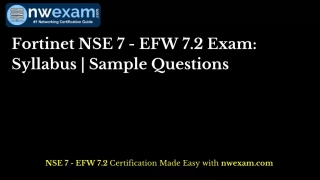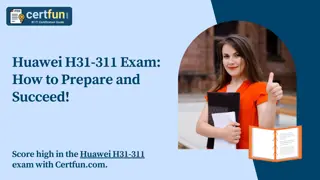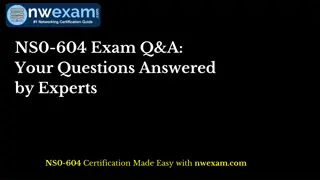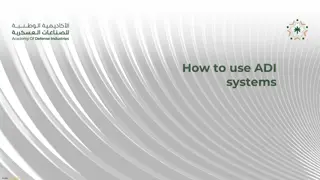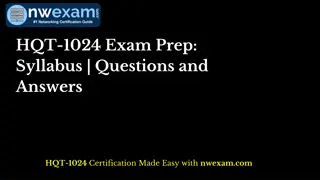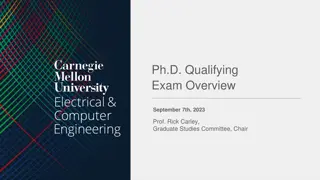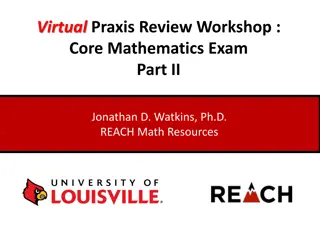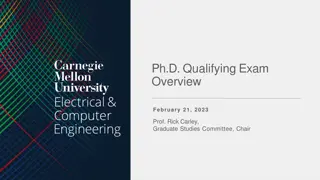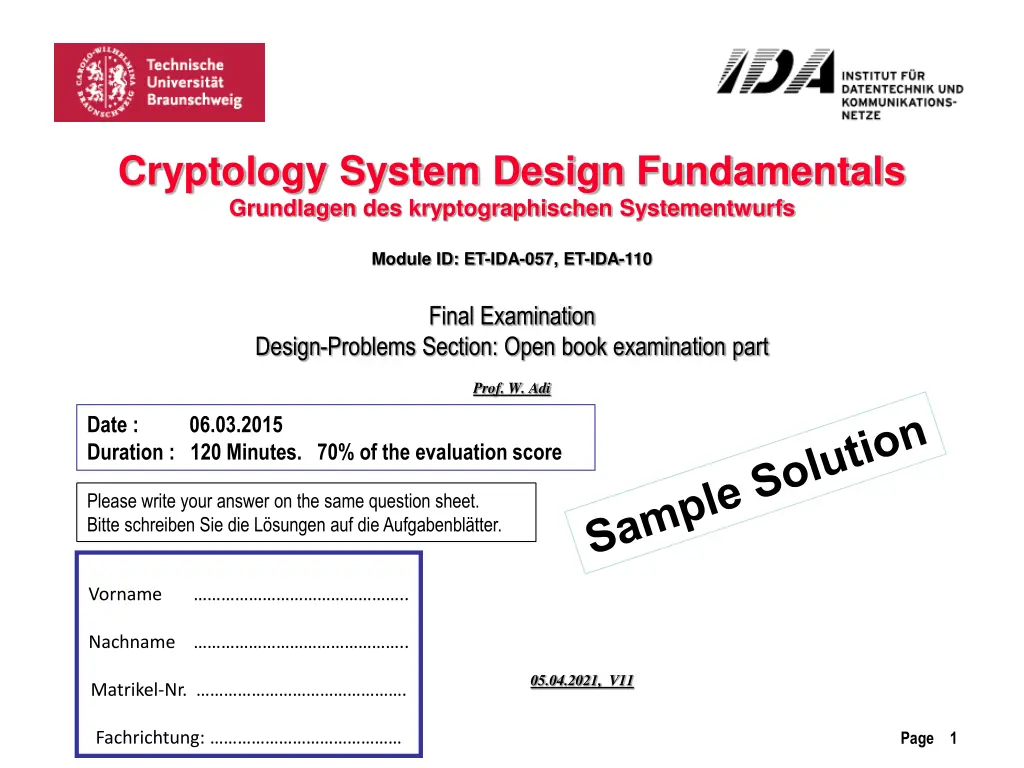
Cryptology System Design Fundamentals: ARSA Cryptosystem Examination
"Explore ARSA cryptosystem design problems involving prime numbers, public and secret keys, message encryption, signatures, and decryption. Learn how to compute keys, verify signatures, and analyze key possibilities for users A and B."
Download Presentation

Please find below an Image/Link to download the presentation.
The content on the website is provided AS IS for your information and personal use only. It may not be sold, licensed, or shared on other websites without obtaining consent from the author. If you encounter any issues during the download, it is possible that the publisher has removed the file from their server.
You are allowed to download the files provided on this website for personal or commercial use, subject to the condition that they are used lawfully. All files are the property of their respective owners.
The content on the website is provided AS IS for your information and personal use only. It may not be sold, licensed, or shared on other websites without obtaining consent from the author.
E N D
Presentation Transcript
Cryptology System Design Fundamentals Grundlagen des kryptographischen Systementwurfs Module ID: ET-IDA-057, ET-IDA-110 Final Examination Design-Problems Section: Open book examination part Prof. W. Adi Date : Duration : 120 Minutes. 70% of the evaluation score 06.03.2015 Please write your answer on the same question sheet. Bitte schreiben Sie die L sungen auf die Aufgabenbl tter. Vorname .. Nachname .. 05.04.2021, V11 Matrikel-Nr. . Page 1 Fachrichtung:
Max 70% marks Marks: Problem 1 Problem 2 Problem 3 Problem 4 Problem 5 Problem 6 Optional Total Page 2
P1: (15 P) ARSA cryptosystem with two users A and B having the following secret prime number pairs: for user A: 53 and 17 and for user B: 41 and 19 1. Find out the adequate public key of user A from the following list of integers: [35, 26, 48] giving the reason for your choice. Compute the corresponding secret key of user A. 2. Find out the adequate public key of user B from the following list of integers: [125,1024,31] giving the reason for your choice. Compute the corresponding secret key of user B. 3. How many public keys are possible for each user? 4. User A encrypts the message M=9, and send the resulting cryptogram YABto B. User A then signs the cryptogram YABand generates the signature SAB. Compute YABand SAB. 5. Decipher the cryptogram YABon user B s site and verify the Signature SAB. 6. User B signs the received message M and sends his signature SBAback toA. Compute the signature SBA. Page 3
Solution: 1. Find out the adequate public key of user A from the following list of integers: [35, 26, 48] giving the reason for your choice. Compute the corresponding secret key of user A. NA = 53 x 17 = 901, (NA ) = (53-1)(17-1) = 832 gcd [ EA, (NA ) ] = 1 => select 35 as gcd (832,35) = 1 EA = 35 DA = -309 mod 832 = 523 (see computation below) 2 DA= 35 -1 mod 832 = -309 + 832 = 523 GCD m 832 35 1 35 27 0 27 8 3 2 u a1 a2 b1 b2 1 -23 24 -95 q 23 27 1 3 2 1 r INVERSE VALUE 0 1 0 1 1 8 3 2 1 0 INVERSE= -309 GCD= 8 3 -1 4 2 4 -9 -95 214 1 -9 13 214 -309 2 1 -1 -23 24 2. Find out the adequate public key of user B from the following list of integers: [125,1024,31] giving the reason for your choice. Compute the corresponding secret key of user B. NB = 41 x 19 = 779 , (NB) = (41-1)(19-1) = 720 gcd (EB, (NB ) ] =1 => select 31 as gcd (720,31) = 1 EB = 31 DB = -209 mod 720 = 511 (see computation below) 2 DB= 31 -1 mod 720 = -209 + 720 = 511 u a1 a2 b1 b2 31 1 0 0 1 7 0 1 1 -23 3 1 -4 -23 93 1 -4 9 93 -209 3 GCD m 720 31 7 3 q 23 7 4 2 r INVERSE VALUE 1 3 1 0 INVERSE= -209 GCD= 3. How many public keys are possible for each user? 2 # of keys for user A = [ (NA )] = (832 ) = (26.13 )= 832(1 -1/2 ) ( 1 1/13 ) = 384 keys # of keys for user B = [ (NB )] = (720 ) = (24 . 32 . 5 )= 720(1 -1/2 ) (1 -1/3 ) (1 -1/5 ) = 192 keys Page 4
4. User A encrypts the message M=9, and send the resulting cryptogram YABto B. User A then signs the cryptogram YABand generates the signature SAB. Compute YABand SAB. D = ???= (?)??mod?? ???= (9)31??? 779 ???= 196 ( ) mod S Y N A AB AB A 3 (196) = = 523 mod 901 780 S AB 5. Decipher the cryptogram YABon user B s site and verify the Signature SAB. Decryption: Verification: = D (SAB)EAmodNA= YABmodNA ( ) mod M Y N check if : B AB B 4 (780)35mod 901= ... = 196 = YAB => signature signature is is authentic! authentic! 31511 (9 = mod 779 M ) = = 15841 mod 720 M 9 mod 779 9 6. User B signs the received message M and sends his signature SBAback to A. Compute the signature SBA. 2 = D ( ) mod S M N B BA B (9) = = 511 mod 779 688 S BA Page 5
P2: (9 P) (b) Ablock cipher with a key length of 256 bits is encrypting a clear text with a block size of 1000 bit having a clear text entropy of 900 bits. 1. Compute the unicity distance of the cipher nu 2. Compute the new unicity distance of the cipher if 500 random bits are appended to each clear text block 3. Is the cipher theoretically breakable after this modification if the attacker can observe 2700 cipher text bits? Solution: Why? K= 256 Bits, H(x)=900 Bits, N= 1000 Bits, r = ? 1. Unicity distance nu = K/r As r = [ N H(x) ] / N => r = (1000 900 ) / 1000 = 0.1 => nu = K/r = 256/0.1 = 2560 Bits 2. n u = [ ( L + N ) / N ] nu n u = [( 500 + 1000 ) / 1000] 2560 n u = 3840 Bits 4 3 3. The number of observed cipher text bits is only 2700 bits and is less than the unicity distance (3840 bits). Therefore, the cipher is theoretically not possible to break 2 Page 6
P3: Compute the multiplicative inverse of (011000000)2 modulo P(x) = (110110001)2and verify your result! (7 P) Solution: B2 = B1 q B2 Extended gcd Algorithm: 5 P1(x) P2(x) B1(x) B2(x) Q(x) R(x) x8+ x7+ x5+ x4+ 1 x7+ x6 x5+ x4+ 1 x 1 0 x2 x3+ x2 x x2 x5+ x4+ 1 x7+ x6 x5+ x4+ 1 1 x x3+1 x2 1 x2 x2 x6+x5+x3+x2+x 0 1 x3+1 2 Verification: x8= x7+ x5+ x4+ 1 x9= x8+ x6+ x5+ x = x7+ x5+ x4+ 1 + x6+ x5+ x = x7+ x4+ 1 + x6+ x x10= x8+ x5+ x + x7+ x2= x7+ x5+ x4+ 1 + x5+ x + x7+ x2 =x4+ 1 + x + x2 x11= x5+ x3+ x2+ x x12= x6+ x4+ x3+ x2 x13= x7+ x5+ x4+ x3 (x6+x5+x3+x2+x) (x7+ x6)-1 = (x6+x5+x3+x2+x) . (x7+ x6) = x13+ x12+ x10+ x9+ x8+ x12+ x11+ x9+ x8+ x7 = x13+ x11+ x10+ x7 = x7+ x5+ x4+ x3+ x5+ x3+ x2+ x + x4+ 1 + x + x2+ x7 = 1 modulo (x8+ x7+ x5+ x4+ 1) Page 7
(21 P) P4: A Diffie-Hellman (DH) public key exchange system uses GF(26) deploying the irreducible polynomial p(x) = x6+ x3 + 1. 1. 2. 3. 4. 5. For = x, compute ifor i = 1 to 10. What is the multiplicative order of x? Which multiplicative orders are possible for elements in GF(26)? Prove that the element = 1+x = 000011 is a primitive element. Compute the multiplicative order of 14 Use the element as a public element in the above GF(26) and compute the DH public keys Yaand Yband the shared secret key ZABfor users A and B having the secret keys Xa=42 und Xb=14. compute the binary vectors for Yaand Yband ZABby making use of the following : 7= x5+ x2, 21 =1 + x3, 6. What is the probability of getting an element with order 21 if the element is picked up randomly from GF(26)?. 7. For any element from GF(26), compute t for which -1 = t . Compute then x-1 mod p(x) using that result. (Hint make use of the results in 1) Verify your result. 2 2 4 2 6 2 3 Page 8
Solution: 1. For = x, compute ifor i = 1 to 10. What is the multiplicative order of x? P(x) = x6+ x3+ 1 = 0 => x6= x3+ 1 x1= x x2= x2 x3= x3 x4= x4 x5= x5 x6= x3 +1 x7= x4+ x x8= x5+ x2 x9= x6+ x3= x3+ x3+ 1 = 1 x10= x ord(x) = 9 2. Which multiplicative orders are possible for elements in GF(26)? Possible orders are the divisors of 26- 1 = 63 Divisors of 63 are: 1,3,7,9,21 and 63 3. Prove that the element = 1+x = 000011 is a primitive element. (x+1)1= x+1 1 (x+1)3= (x+1)2 . (x+1) = (x2+1).(x+1)= x3+x2+x+1 1 (x+1)7= ((x+1)3)2. (x+1) = (x3+x2+x+1)2 . (x+1)= (x6+x4+x2+1) . (x+1) = x7+x5+x3+x+ x6+x4+x2+1 =x4+x+x5+x3+x+ +x3+1+x4+x2+1 =x5+ x2 1 (x+1)9= (x+1)7. (x+1)2= (x5+x2). (x2+1)= x7+x4+x5+x2= x4+x+x4+ x5+x2=x5+x2+x 1 (x+1)21= ((x+1)7)3= (x5+x2)3 = (x5+x2)2 .(x5+x2) = (x10+x4).(x5+x2) = (x+x4).(x5+x2) = x6+x3+x9+ x6= x3+1 1 ord (x+1) = 63 X6= x3+ 1 X7= x4+ x X8= x5+ x2 x9= x6+ x3 = x3+ x3+ 1 = 1 x10= x Page 9
4. Compute the multiplicative order of 14 ( ) 63 63 ord = = = = 14 ( ) 9 ord gcd( ( ), ) gcd( 63 14 , ) 7 ord i 5. Use the element as a public element in the above GF(26) and compute the DH public keys Yaand Yband the shared secret key ZABfor users A and B having the secret keys Xa=42 und Xb=14. compute the binary vectors for Yaand Yband ZABby making use of the following : = x+1, 7= x5+ x2, 21 =1 + x3, Public directory GF(26) = x+1, P(x) = x6+ x3+ 1 Ya = x3 = 001000 Yb = x4+x =010010 User A: Xa= 42 , Ya = 42 =(x+1)42mod(x6+x3+1) = ((x+1)21)2= ( 21 )2 = (x3+1)2 =x6+1 = x3+1 + 1 = x3 =001000 User B: Xb = 14 , Yb = 14 = ( 7 )2 = (x5+x2)2 =x10+x4 = x4+ x = 010010 Common secret key for users A and B Zab = 42.14 mod 63 =(x+1)42 . 14 mod 63 = (x+1)21 = x3+1 Zab= x3+ 1 = 001001 6. What is the probability of getting an element with order 21 if the element is picked up randomly from GF(26)?. # of all non-zero elements : 26-1 = 63 # of elements with order 21: ( 21) = ( 7 x 3) =(7-1).(3-1) = 6 . 2 = 12 Probabilty of (element s order=21) = ( 12 / 63 ) . 100 = 19.05 % Page 10
7. For any element from GF(26), compute t for which -1 = t . Compute then x-1 mod p(x) using that result. (Hint make use of the results in 1) Verify your result. For any element t, -1 mode 63 = -1 + 63 = 62= t t = 62 x-1 = x62 = (x9)6.x8 = (1 )6.x8 = x8 x-1= x8 = x5+ x2 Verification: x. x-1 = x .x8= x9= 1(see 1) Page 11
(15 P) P5: El-Gamal crypto system is set up using the prime number N = 2 281 + 1 = 563 generated by applying Pocklington s Theorem, where q=281 is a prime. 3 1. 2. Prove that N is a prime according to Pocklington s Theorem. Find a primitive element in GF(563) and use it as a public element in ElGamal public key system (show all necessary computations). User A encrypts the message M=33 and send it to user B who has the secret key Xb= 70 by using the random number R=17. Compute B s public keyYband the encrypted message Caand r. Decrypt the cryptogram Caon the receiver side B showing all necessary computations therefore. Let user A having the secret key Xa= 133 compute his Signature Saaccording to ElGamal signature scheme shown below for the same message M=33 . Select one adequate k from the following list (k = 22,270,89). 2 3. 5 4. 5. 2 3 public directory User A signs M Verifier is primitive in GF(N) ya= public key of A Xa= Secret Key of A p, , ya Xa= ya If M M M = yar. r S mod N k-1( M - r . Xa) mod (N-1) = S S Then M is authentic k= r k r k Random unit in ZN-1 Signed Message Sa Page 12
Solution: 1. Prove that N is a prime according to Pocklington s Theorem. N = R . F + 1= 2 281 + 1 = 563, F = 281 is a prime, and R = 2. Is N=563 a prime? (1) Choose a=2. Proof: 1. gcd ( a (N-1)/ pj 1 , N ) = gcd ( a (563-1)/ 281 1 , N ) = gcd ( 22 1 , 563) = gcd ( 3 , 563) = 1 is true 2. a N-1= 1 ( mod N ) 2562= 1 (mod 563) is true 3. F > N 281 > 563= 23.7 => 281> 23.7 is true As all conditions 1, 2 and 3 are all true 563 is for sure a prime number 2. Find a primitive element in GF(563) and use it as a public element in ElGamal public key system (show all necessary computations). Possible orders are the divisors of (563 -1) = 562 Divisors of 562 are: 1,2,281 and 562 as can be seen from (1) Checking if the element 2 is primitive 2 1 mod 563 1 , 2 2mod563 1 , 2 281mod563 = 562 1 Ord (2) = 562 = 2 is primitive element Page 13
3. User A encrypts the message M=33 and send it to user B who has the secret key Xb= 70 by using the random number R=17. Compute B s public key Yband the encrypted message Caand r. Encryption: Public directory User A. M = 33 User B. Xb = 70 Yb = Xbmod p= 270mod 563 = 445 = 2 , GF(563) YB = 2 70mod 563= 445 r = R= 217 mod 563 = 456 Ca= M . YBR= 33 . (270) 17 mod 563= 33. 63 = 390 4. Decrypt the cryptogram Caon the receiver side B showing all necessary computations, therefore. Decryption: Z-1= ( R) -Xb= r -Xb= 456 -70 mod 562 mod 563 = (456-70+562)mod 563 = 143 M = Ca. Z-1 = 390 143 mod 563 = 33 Page 14
5. Let user A having the secret key Xa= 133 compute his Signature Saaccording to ElGamal signature scheme shown below for the same message M=33 . Select one adequate k from the following list (k = 22,270,89). public directory User A signs M Verifier is primitive in GF(N) ya= public key of A Xa= Secret Key of A p, , ya Xa= ya If M M M = yar. r S mod N k-1( M - r . Xa) mod (N-1) = S S Then M is authentic k= r k r k Random unit in ZN-1 Signed Message Sa K has to be invertible mod N-1, N-1=562 gcd [ k, N-1 ] = 1 => select 89 from the list (k = 22,270,89) . As gcd (562,89) = 1 K = 89 , 89-1 = -221 mod 562 = 341 (see table below) r = k= 289 mod 563 = 397 S = k-1( M - r . Xa) mod (N-1) = 89-1(33- 397 . 133) mod 562 = 341 (33 52801) mod 562 = 341 . (-52768)mod 562 S = -17993888 mod 562 = -334 + 562 = 228 GCD m 562 89 28 5 3 2 u 89 28 5 3 2 1 -19 35 120 -221 2 0 INVERSE= a1 a2 1 0 1 -3 16 -19 -101 120 1 1 b1 0 1 -6 19 b2 1 -6 19 -101 1 2 q r 6 28 3 5 5 3 INVERSE VALUE = 0 1 -3 16 -221 GCD= 1 Page 15
(11 P) P6: A Massey-Omura lock for Shamir s 3-Pass Protocol over GF(28) using the irreducible polynomial p(x) = x8+ x7+ x3+ x + 1 as a field modulus is set up. (Hint: 28-1 = 3 5 17 ) 1. Write p(x) in binary form and find out the multiplicative order of x (by using the list of binary irreducible polynomials). 1,5 2. Compute the powers of x in GF(28) ( x9and x10). 3. The secret key for users A and B are 7 and 13 respectively. A message M = x8is sent from A to B. Compute all the exchanged 3-pass messages as powers of x with smallest possible power of x. 4. Compute the number of possible secret keys in case that the sent clear text message M was only selected as a power of x. (that is M=xifor some i). 5. What is the maximum number of exponentiation search cycles required to break a message of the form (M=xi) ? Why? 1,5 2 3 3 Page 16
Solution: 1. Write p(x) in binary form and find out the multiplicative order of x (by using the list of binary irreducible polynomials). The polynomial binary pattern is : p(x) = x8 + x7 + x3+ x + 1 = 110001011 order of x modulo p(x) is 85. x85 =1 e of p(x) is = 85 ( see list of irreducible polynomials in the lecture slides) 2. Compute the powers of x in GF(28) ( x9and x10). p(x) = x8 + x7 + x3+ x + 1 = 0 => x8 = x7 + x3+ x + 1 x9 = x8 + x4+ x2+ x = (x7 + x3+ x + 1) + x4+ x2+ x = x7 + x3+ 1+ x4+ x2 x10 =x * x9 = x *( x7 + x3+ 1+ x4+ x2 ) = x8 + x4+ x+ x5+ x3= (x7 + x3+ x + 1) + x4+ x+ x5+ x3= x7+ 1 + x4+ x5 Page 17
3. The secret key for users A and B are 7 and 13 respectively. A message M = x8 is sent from A to B. Compute all the exchanged 3-pass messages as powers of x with smallest possible power of x. A B Eb= 13 as gcd(28-1,13)=1 Db = Eb-1(mod 28-1) Db = 13-1(mod 255)= -98 = -98+255= 157 Public directory : GF(28), polynomial p(x) = x8 + x7 + x3+ x + 1 Ea=7 as gcd(28-1,7) = 1 Da = Ea-1(mod 28-1) Da = 7-1(mod 255)= 73 As the order of x is 85, the modulus in the exponents of x is 85 !!! Y1= MEa= x8 . 7= x56 Y1= x56 M = x8 Y2= (Y1)Eb Y2= x48 Y2= (Y1)Eb = MEa . Eb mod p-1 = x56 . 13 mod 85= x48 Y3= (Y2)Da=MEa . Eb . Da mod p-1 = x48 . 73 mod 85= x19 Y3 = x19 M = (Y3)Db mod p-1 = ( x19)157 mod 85 M = x8 GCD m 255 7 3 u 7 3 1 a1 a2 1 0 1 b1 0 1 -36 b2 1 -36 2 1 73 q r # 3 INVERSE VALUE = GCD m m 255 13 8 5 3 2 u u 13 8 5 3 2 1 a1 a1 1 0 1 -1 2 -3 a2 a2 0 1 -1 2 -3 5 b1 b1 0 1 -19 20 -39 59 b2 b2 1 -19 20 -39 59 -98 q q 19 1 1 1 1 2 r r 8 5 3 2 1 0 INVERSE VALUE = B2 0 1 -2 3 0 INVERSE= 73 GCD= 1 INVERSE= -98 GCD= 1 Page 18
4. Compute the number of possible secret keys in case that the sent clear text message M was only selected as a power of x. (that is M=xifor some i). If the attacker knows that the sent messages are powers of x, then the modulus in the exponent is 85 (85 is the order of x). The number of distinct messages is then only 85 The cryptographically significant keys are those usable for 85 as a modulus instead of 255. The usable keys are those which are invertible modulo 85. The number of such keys is (85) = (5 x 17) =(5-1).(17-1)= 4 x 16 = 64 keys. 5. What is the maximum number of exponentiation search cycles required to break a message of the form (M=xi) ? Why? As the maximum number of search cycles to compute the discrete logarithm is the maximum order involved in the terms to be attacked. The attacked term in that case is xi. The order of any element having the form (xi ) for any i is = 85/ gcd(85,i). The maximum value for the order is for i such that gcd(85,i) =1. That is the maximum order is 85 and the maximum number of simple search cycles to get the discrete logarithm is 85. Breaking a system is reached if the secret key could be found for one encrypted message as Y1in this example. Page 19


